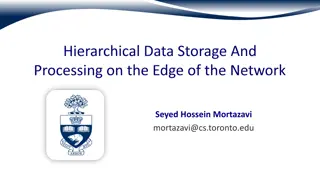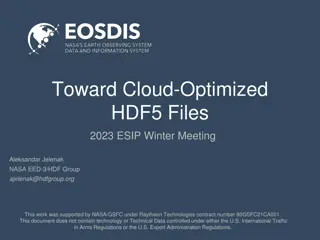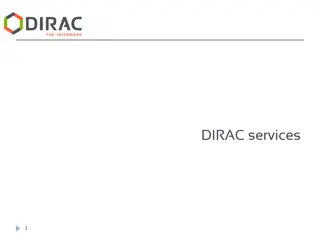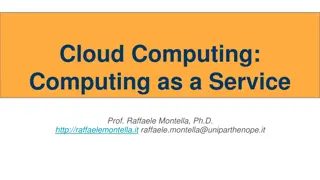The Dangers of Gossip in Cloud Computing
Gossip protocols in cloud computing can be both beneficial and risky. While they have low costs and spread information efficiently, caution is needed as seen in the case where gossip caused Amazon S3 to crash, impacting numerous companies. Understanding how gossip protocols work and their potential implications is crucial in cloud computing environments.
Download Presentation

Please find below an Image/Link to download the presentation.
The content on the website is provided AS IS for your information and personal use only. It may not be sold, licensed, or shared on other websites without obtaining consent from the author.If you encounter any issues during the download, it is possible that the publisher has removed the file from their server.
You are allowed to download the files provided on this website for personal or commercial use, subject to the condition that they are used lawfully. All files are the property of their respective owners.
The content on the website is provided AS IS for your information and personal use only. It may not be sold, licensed, or shared on other websites without obtaining consent from the author.
E N D
Presentation Transcript
CS5412 / LECTURE 13: THE DANGERS OF GOSSIP Lecture V Ken Birman Spring, 2021 CS5412 CLOUD COMPUTING, SPRING 2021 1
REMINDER: GOSSIP These protocols consume a fixed amount of background overhead. There are no load surges (but Bimodal Multicast can cause burst loads: why?) Costs are quite low, like on average, one message sent and one received per process, per second . Message sizes are generally small. Moreover, information spreads in time r * O(log N), where r is the gossip rate. For many purposes this actually very reasonable. CS5412 CLOUD COMPUTING, SPRING 2021 2
SO WHY NOT USE GOSSIP EVERYWHERE? There are many tasks where the fit seems quite good. Like checking to see if systems have hung processes, or monitoring loads, or tracking storage capacity on storage units. The underlying values change slowly, so even a slow tracker will still be pretty accurate. CS5412 CLOUD COMPUTING, SPRING 2021 3
BUT THERE ARE SOME CAUTIONARY TALES For example, gossip once caused all of Amazon S3 to crash! This nearly resulted in a congressional inquiry! When S3 crashes, a great many companies also freeze up any company that depends on the cloud depends on the S3 file system storage solution. So what is S3 and how does it use gossip? CS5412 CLOUD COMPUTING, SPRING 2021 4
AMAZON S3: THE SIMPLE STORAGE SERVER S3 is a huge pool of storage nodes. Plus, a meta-data server that keeps track of file names and where they can be found. To store data, an application asks the meta-data service to allocate space, then sends the data to the appropriate storage servers. CS5412 CLOUD COMPUTING, SPRING 2021 5
WHY DO WE USE THE TERM META-DATA? When you think about a file, you tend to think of the file name and the file contents. Like a key and a value. But in fact files also have owners, permissions, create time, last access time, length (and perhaps, size on disk, which can be much smaller), etc. We associate this data with the file. In Linux the inode plays this role. In S3 and other big-data systems, the meta-data service does it. CS5412 CLOUD COMPUTING, SPRING 2021 6
HOW DOES THE S3 META-DATA SERVICE TRACK SPACE AVAILABLE ON STORAGE UNITS? You might expect this to be easy, because the meta-data service does the allocations. But in fact the meta-data service itself is sharded, so any single shard within it only knows (for sure) about files it is responsible for. Additionally, sometimes a server needs to take some storage offline. To know the full state of the full S3 deployment we would need to sum across all meta-data services. CS5412 CLOUD COMPUTING, SPRING 2021 7
LOAD BALANCING For each server, estimate current amount of free space. Line them up on a space available line. server 1 server 2 server 3 server 4 server 5 server 6 For a new allocation, pick a random spot in this line. This spreads the incoming load around but will be biased to favor servers with more space. CS5412 CLOUD COMPUTING, SPRING 2021 8
GOSSIP IS USED FOR TRACKING STORAGE Amazon used a gossip protocol in this role, specialized to S3 meta-data. The basic idea is to use gossip to keep track of how much space each S3 storage node is reporting that it has available. This is inexpensive and because each storage unit holds hundreds of gigabytes, the values don t change rapidly. A good match for gossip. CS5412 CLOUD COMPUTING, SPRING 2021 9
UNTIL IT WENT WRONG! Once upon a time, when S3 was working perfectly well, a storage server needed to take some storage offline. Because of doing this, it suddenly went from having 20% excess capacity to being slightly over-full. This was not a bug the servers actually have a tiny bit of reserve space, so available capacity could become slightly negative. As it turns out, S3 storage servers reported space available as signed 32 bit integers. But the S3 meta-data service declared the same field to be a 32 bit unsigned integer. This was a marshalling bug. CS5412 CLOUD COMPUTING, SPRING 2021 10
I HAVE -3 GB OF FREE CAPACITY Suppose that we have a signed integer that becomes negative, and then we interpret it as an unsigned integer? The sign bit will be set. 2^31 is a large number! In effect, small negative numbers will suddenly be interpreted as big positive numbers. Our server suddenly reports: I have 2147483645 gigabytes of free capacity! CS5412 CLOUD COMPUTING, SPRING 2021 11
SUDDENLY LOTS OF NEW FILES WERE SENT TO THIS STORAGE SERVER! Since it was full, it refused the requests. S3 did have logic to handle that situation. But it became a bottleneck. S3 became e x t r e m e l y . . . s l o w CS5412 CLOUD COMPUTING, SPRING 2021 12
IMAGINE THE SITUATION FOR S3 PRODUCT OWNERS AT AMAZON One evening you are home with your family for Thanksgiving (pre-covid) You get a call its Jeff Bezos S3 is broken! Could you please go figure out why and fix it? So while everyone else is carving the turkey you log in and see millions of errors being logged per second from 75 subsystems CS5412 CLOUD COMPUTING, SPRING 2021 13
IT TOOK AMAZON NEARLY A DAY TO FIGURE THIS OUT S3 was actually working! It did store new files. But it was weirdly slow. Higher level applications that depend on S3 began to have request timeouts, causing a cascade of failures. This issue of one failure triggering other failures is a major problem see in the cloud and causes a whole series of outages all to happen at once. CS5412 CLOUD COMPUTING, SPRING 2021 14
FROM BAD TO WORSE? They eventually found the issue, and came up with a great idea! They shut down the bad server. But nothing happened Gossip is very slow to spread the word. So then they noticed that meta-data server md1 was gossiping that server 53 had infinite space. They killed it. Suddenly, md2 took over and started gossiping that 53 had infinite space CS5412 CLOUD COMPUTING, SPRING 2021 15
ISSUES YOU SEE IN THIS STORY With gossip, fresher data might not always spread faster than stale data Gossip is very robust to servers being down, which means that just rebooting a single node won t fix anything. Message serialization/deserialization doesn t necessarily check for type matches. In this case, it didn t and so a signed integer can magically be reinterpreted as an unsigned integer. CS5412 CLOUD COMPUTING, SPRING 2021 16
A THOUGHT QUESTION What s the best way to Count the number of nodes in a system? Compute the average load, or find the most loaded nodes, or least loaded nodes? Options to consider Pure gossip solution Construct a service that actively tracks the nodes, or the load, etc? Leiden; Dec 06 GOSSIP-BASED NETWORKING WORKSHOP 17
AND THE ANSWER IS Gossip isn t very good for some of these tasks! There are gossip solutions for counting nodes, but they give approximate answers and run slowly Tricky to compute something like an average because of re-counting effect, (best algorithm: Kempe et al) On the other hand, gossip works well for finding the c most loaded or least loaded nodes (constant c) Gossip solutions run in time O(log N) and generally give probabilistic solutions Leiden; Dec 06 GOSSIP-BASED NETWORKING WORKSHOP 18
REMINDER: ASTROLABE It creates a virtual tree of nodes. At the leaf level, the tree tracks status for individual machines. At the inner levels (these are virtual tables) aggregation queries are computed from the lower levels and shared. Lightly loaded leaf nodes run the inner-level gossip protocol Leiden; Dec 06 GOSSIP-BASED NETWORKING WORKSHOP 19
STATE MERGE: CORE OF ASTROLABE EPIDEMIC Name Time Load Weblogic? SMTP? Word Version swift 2011 2.0 0 1 6.2 falcon 1971 1.5 1 0 4.1 cardinal 2004 4.5 1 0 6.0 swift.cs.cornell.edu Name Time Load Weblogic ? SMTP? Word Version swift 2003 .67 0 1 6.2 falcon 1976 2.7 1 0 4.1 cardinal 2201 3.5 1 1 6.0 cardinal.cs.cornell.edu Leiden; Dec 06 GOSSIP-BASED NETWORKING WORKSHOP 20
STATE MERGE: CORE OF ASTROLABE EPIDEMIC Name Time Load Weblogic? SMTP? Word Version swift 2011 2.0 0 1 6.2 falcon 1971 1.5 1 0 4.1 cardinal 2004 4.5 1 0 6.0 swift.cs.cornell.edu swift 2011 2.0 cardinal 2201 3.5 Name Time Load Weblogic ? SMTP? Word Version swift 2003 .67 0 1 6.2 falcon 1976 2.7 1 0 4.1 cardinal 2201 3.5 1 1 6.0 cardinal.cs.cornell.edu Leiden; Dec 06 GOSSIP-BASED NETWORKING WORKSHOP 21
STATE MERGE: CORE OF ASTROLABE EPIDEMIC Name Time Load Weblogic? SMTP? Word Version swift 2011 2.0 0 1 6.2 falcon 1971 1.5 1 0 4.1 cardinal 2201 3.5 1 0 6.0 swift.cs.cornell.edu Name Time Load Weblogic ? SMTP? Word Version swift 2011 2.0 0 1 6.2 falcon 1976 2.7 1 0 4.1 cardinal 2201 3.5 1 1 6.0 cardinal.cs.cornell.edu Leiden; Dec 06 GOSSIP-BASED NETWORKING WORKSHOP 22
ASTROLABE BUILDS A HIERARCHY USING A P2P PROTOCOL THAT ASSEMBLES THE PUZZLE WITHOUT ANY SERVERS Dynamically changing query output is visible system-wide SQL query summarizes Name Name Name Avg Load Load Load Avg Avg WL contact WL contact WL contact SMTP contact SMTP contact SMTP contact SF SF SF 2.6 2.6 2.2 123.45.61.3 123.45.61.3 123.45.61.3 123.45.61.17 123.45.61.17 123.45.61.17 NJ NJ NJ 1.8 1.8 1.6 127.16.77.6 127.16.77.6 127.16.77.6 127.16.77.11 127.16.77.11 127.16.77.11 data Paris Paris Paris 3.1 3.1 2.7 14.66.71.8 14.66.71.8 14.66.71.8 14.66.71.12 14.66.71.12 14.66.71.12 Name Name Name Load Load Load Weblogic? Weblogic? Weblogic? SMTP? SMTP? SMTP? Word Version Version Version Word Word Name Name Name Load Load Load Weblogic? Weblogic? Weblogic? SMTP? SMTP? SMTP? Word Version Version Version Word Word swift swift swift 2.0 2.0 1.7 0 0 0 1 1 1 6.2 6.2 6.2 gazelle gazelle gazelle 1.7 1.7 4.1 0 0 0 0 0 0 4.5 4.5 4.5 falcon falcon falcon 1.5 1.5 2.1 1 1 1 0 0 0 4.1 4.1 4.1 zebra zebra zebra 3.2 3.2 0.9 0 0 0 1 1 1 6.2 6.2 6.2 cardinal cardinal cardinal 4.5 4.5 3.9 1 1 1 0 0 0 6.0 6.0 6.0 gnu gnu gnu .5 .5 2.2 1 1 1 0 0 0 6.2 6.2 6.2 New Jersey San Francisco Leiden; Dec 06 GOSSIP-BASED NETWORKING WORKSHOP 23
ANOTHER REALLY BAD STORY A company experimented with using Astrolabe In their experiment, which was never deployed in practice, they had the idea that instead of the least loaded leaf nodes playing the inner gossip role, every node would have an equal role. So they came up with a new kind of Astrolabe tree CS5412 CLOUD COMPUTING, SPRING 2021 24
AN UNFAIR AGGREGATION TREE D L B J F N A C E G G gossips with H and learns e I K M O An event e occurs at H P learns O(N) time units later! A B C D E F G H I J K L M N O P Leiden; Dec 06 GOSSIP-BASED NETWORKING WORKSHOP 25
WAIT! P LEARNS N TIME-STEPS LATER? Wasn t Astrolabe supposed to run in O(log N) time? Why is it suddenly running in time O(N)? CS5412 CLOUD COMPUTING, SPRING 2021 26
WHAT WENT WRONG? In this horrendous tree, each node has equal work to do but the information-space diameter is larger! Astrolabe was actually benefitting from instant knowledge because the epidemic at each level is run by someone elected from the level below Leiden; Dec 06 GOSSIP-BASED NETWORKING WORKSHOP 27
INSIGHT: TWO KINDS OF SHAPE We ve focused on the aggregation tree But in fact should also think about the information flow tree Our example was showing how an information flow tree can be slow. Leiden; Dec 06 GOSSIP-BASED NETWORKING WORKSHOP 28
INFORMATION SPACE PERSPECTIVE Bad aggregation graph: diameter O(n) D L B J F N H G E F B A C D L K I J N M O P A C E G I K M O A B C D E F G H I J K L M N O P Astrolabe version: diameter O(log(n)) A I A I E M C D A B G H E F A C E G I K M O K L M N I J O P A B C D E F G H I J K L M N O P Leiden; Dec 06 GOSSIP-BASED NETWORKING WORKSHOP 29
WHAT ABOUT THE UDP MULTICAST TRICK? UDP multicast (like in Bimodal Multicast) really speeds up datacenter gossip multicast. We could easily modify Astrolabe to do this too now most nodes get infected right away, and we would have a bimodal query response time that would be very fast. People have explored this, too. CS5412 CLOUD COMPUTING, SPRING 2021 30
INFORMATION SPACE PERSPECTIVE UDP multicast causes a fast all to most exchange. Then a few stragglers need to catch up in the next gossip round or two: A B C D E F G H I J K L M N O P P A C D E G H I F B In this UDP-multicast accelerated graph, we get a very accelerated covergence J K L M N O CS5412 CLOUD COMPUTING, SPRING 2021 31
BUT UDP MULTICAST CAN HAVE ISSUES TOO Imagine a gossip system with 100,000 nodes using UDP multicast to accelerate reporting of important events. Now suppose that the lights flicker or some other system-wide issue occurs and all 100,000 nodes remain operational but notice. So now 100,000 machines all have news to report! They send 100,000 UDP multicast simultaneously which is way more than we planned on! CS5412 CLOUD COMPUTING, SPRING 2021 32
WILL THIS CAUSE A PROBLEM? The network itself can handle the surge. It probably runs at around 75M messages per second, on the wire layer. So 100,000 messages do get through. But a standard Linux server, high-end hardware, can t receive more than 10,000 UDP messages per second. This becomes the bottleneck CS5412 CLOUD COMPUTING, SPRING 2021 33
90,000 UDP MESSAGES GET DROPPED In fact those Linux servers need to work hard to receive but then drop so many messages. It causes a huge overload. The whole data center grinds to a halt. Lots of other services begin to get timeouts due to unresponsive servers, causing even more errors to report CS5412 CLOUD COMPUTING, SPRING 2021 34
IN FACT UDP MULTICAST STORMS ARE A FAMOUS THREAT IN DATACENTERS Many years ago there were a number of products in the message bus and data distribution system space that used this feature. To understand the issue (which has nothing to do with gossip!) it helps to understand how UDP multicast really works. CS5412 CLOUD COMPUTING, SPRING 2021 35
THE BASIC MECHANISMS First, the IP system reserves a class of IP addresses for use in UDP multicast. They are class D addresses, and we can think of each one as a unique id plus a unique port number shared by a set of receivers. For example, Ken s Magic Message Bus might reserve IP address D:224.10.20.30 port number 7890. Every server process in the KMMB service has this hard-wired in. CS5412 CLOUD COMPUTING, SPRING 2021 36
THE BASIC MECHANISMS When a machine boots, the KMMB server instance launches. It creates a socket and binds this standard IP address and port to it. This causes the NIC to begin to watch for messages that match. In addition, the top of rack switch and datacenter routers are informed that there is a new multicast listener on this segment of the network. They make note of this. CS5412 CLOUD COMPUTING, SPRING 2021 37
CONCEPT: A BLOOM FILTER: A WAY TO TRACK SET MEMBERSHIP CHEAPLY (O(1) INCLUSION COST) A Bloom filter is a set of (usually) 3 bit-vectors of some length (usually) 1K To remember X, the filter computes hash(X), hash(X+1), hash(X+2) and sets the corresponding bit in vector 0, 1 and 2. Later to answer the question does this filter include X we repeat but this time check the bits. Answer yes if all 3 bits are set, no if not. CS5412 CLOUD COMPUTING, SPRING 2021 38
USE OF THESE FILTERS? The NIC uses a Bloom filter to recognize incoming IP multicast packets it should accept. The TOR switch uses a Bloom filter to track which rack has machines listening for a particular IP multicast address. The fat-tree of datacenter routers uses this to remember which subnetworks have a machine listening for an IP multicast address. CS5412 CLOUD COMPUTING, SPRING 2021 39
EXAMPLE: NODES A, B AND C ARE IN IP MULTICAST GROUP OF KMMB A B C CS5412 CLOUD COMPUTING, SPRING 2021 40
A SENDS A MULTICAST Suppose we want to publish some event from A to KMMB? A prepares a UDP packet, puts the special address in it, and calls sendto At each stage it will be forwarded towards any receivers CS5412 CLOUD COMPUTING, SPRING 2021 41
EXAMPLE: NODES A, B AND C ARE IN IP MULTICAST GROUP OF KMMB A B C CS5412 CLOUD COMPUTING, SPRING 2021 42
BLOOM FILTER ROLE? At the line rate of the network (75M packets/second) we have very little time to decide where to forward copies. The Bloom filter can be implemented in hardware (the hashing policy is the expensive step) and runs fast enough to make the decision before the switch or router exceeds its available time So we get a very clean UDP multicast that might show up multiple times per receiver, but won t bother non-receivers CS5412 CLOUD COMPUTING, SPRING 2021 43
SOME USES Maybe KMMB is super popular. Each user has their own instance. Also, very useful for tracking debug data and network management properties. If nobody is listening, the network itself automatically discards the UDP packets! so perhaps we see a linear adoption . Maybe for every 500 machines we see one additional thing using UDP multicast. CS5412 CLOUD COMPUTING, SPRING 2021 44
WHAT DOES THIS TELL US? When the datacenter was small, it worked awesomely. But suppose our datacenter has 1M computers just yesterday Jeff Bezos gave the order and we doubled the size! 1M / 1500 = 660. Our Bloom Filter bit vectors only had 1024 bits. So now most of them will be set. Yesterday with 500,000 machines this wasn t the case only 330 were set, per vector. CS5412 CLOUD COMPUTING, SPRING 2021 45
FALSE POSITIVES As we scale up the data center, more and more of the UDP packets are going to be forwarded to more and more machines, due to Bloom Filter matches. In effect we go from the network filtering out no receiver packets to forwarding them, many copies each, on every link. This overloads the network and it becomes lossy. It may also overload individual machines if some machines are listening for many IP multicast addresses CS5412 CLOUD COMPUTING, SPRING 2021 46
WE CALL THESE MULTICAST STORMS The term refers to an all-to-all message pattern that overwhelms the entire data center. Basically, a single event ended up crashing the whole datacenter within seconds! CS5412 CLOUD COMPUTING, SPRING 2021 47
THESE PROBLEM HAVE ACTUALLY BEEN SEEN! One result is that most modern data centers disable UDP multicast. Either trying to use it always gives errors or, more common, when you try to use it they automatically set up TCP connections and route your messages over TCP. For smaller multicast groups this works but you can t make 100,000 TCP connections from one node to 100,000 other nodes. So we can t use the UDP speedup feature in most datacenter systems. CS5412 CLOUD COMPUTING, SPRING 2021 48
SUMMARY Gossip is tricky! UDP multicast is tricky too! In fact everything except TCP seems to be risky! A gossip mechanism will have constant, low overheads and very predictable delay, provided that the information sharing graph is of low diameter. But small mistakes can yield gossip solutions that actually malfunction in major ways, potentially shutting down entire datacenters! Leiden; Dec 06 GOSSIP-BASED NETWORKING WORKSHOP 49























